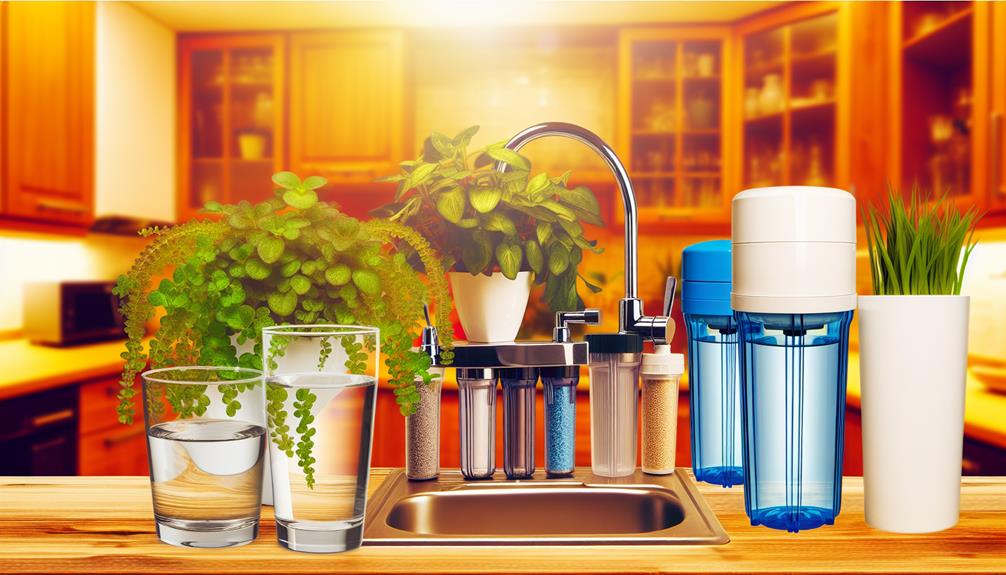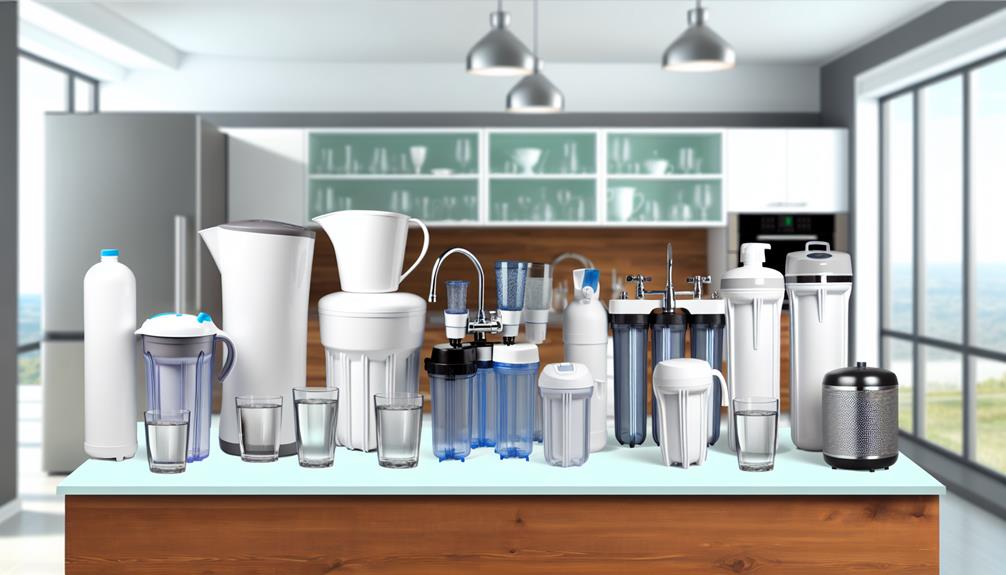Just as Odysseus navigated the treacherous waters of the ancient world, you too are embarking on a journey to sift through the complex sea of home water filtration systems.
It's essential to understand the strengths and limitations of the various types available, from reverse osmosis systems that strip away the minutest contaminants to activated carbon filters that remove odors and improve taste.
You'll want to consider whole house filtration for comprehensive coverage, or perhaps the targeted defense provided by under sink and countertop solutions.
And let's not forget the modern marvel of ultraviolet disinfection units, which offer a chemical-free method to kill bacteria and viruses.
As you weigh the benefits against the costs and maintenance requirements, remember that the quest for pure, clean water is as vital to your home as it was for survival in ancient tales.
Stay with us as we unveil the top contenders that may just hold the key to your own domestic odyssey.
Reverse Osmosis Systems
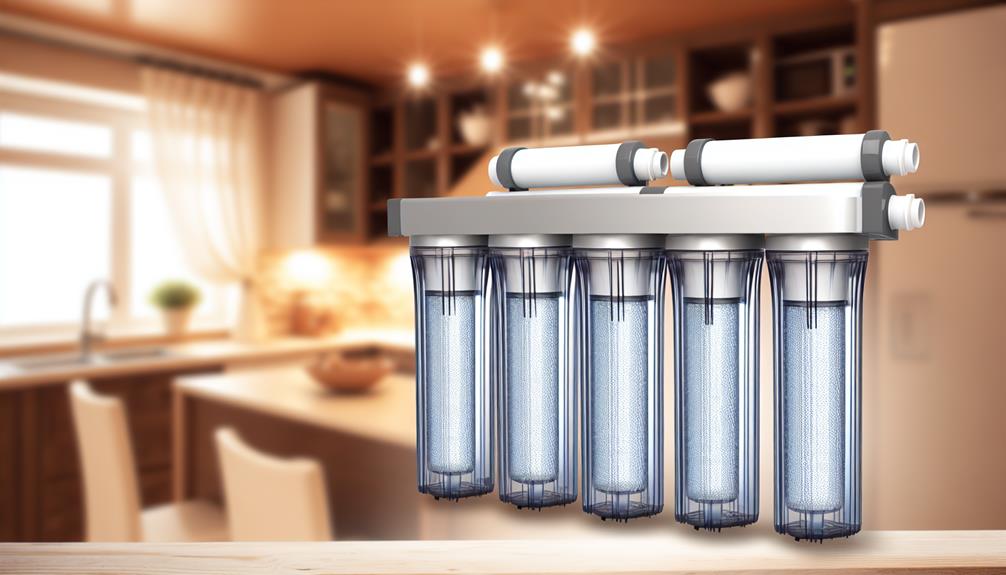
Reverse osmosis systems effectively remove impurities from water using a semipermeable membrane, making them a popular choice for home water filtration. Analyzing their performance, you'll find that these systems can significantly reduce a wide array of contaminants, including dissolved salts, bacteria, and pyrogens. However, one technical consideration you must weigh is water waste. Reverse osmosis typically expels several gallons of water as waste for every gallon of filtered water produced. This ratio can be a concern in areas where water conservation is a priority.
The initial cost is another factor to examine when considering a reverse osmosis system. These units tend to be more expensive upfront compared to other filtration options. The complexity of the system, which often includes pre-filters, the reverse osmosis membrane, and post-filters, contributes to the higher cost. Moreover, professional installation might be necessary to ensure optimal functionality, further adding to initial expenses.
In your analysis, balance these considerations with the benefits of highly purified water. The system's efficacy in reducing unwanted elements must be juxtaposed with the sustainability and economic implications of its operation.
Activated Carbon Filters
You'll find that activated carbon filters utilize adsorption, where contaminant molecules are trapped inside the pore structure of the carbon substrate.
Evaluating their efficiency requires understanding the spectrum of contaminants they remove, including chlorine, volatile organic compounds (VOCs), and certain pesticides.
Regular maintenance is crucial for these filters, as their effectiveness diminishes with use, impacting both water quality and filter lifespan.
How Carbon Filters Work
Activated carbon filters, a prevalent choice for home water purification, operate by adsorbing contaminants onto their expansive surface area. This process, known as chemical adsorption, involves the following steps:
- Attraction: As water passes through the filter media, contaminants are attracted to the surface of the activated carbon.
- Bonding: Chemical bonds form between the contaminants and the carbon, effectively removing them from the water.
- Pore Size: The activated carbon has a porous structure, which increases the surface area for adsorption.
- Capture: Organic compounds and chlorine are among the substances captured by the filter, improving the taste and odor of the water.
This technical process ensures that you're provided with cleaner, more palatable drinking water through a sophisticated yet straightforward filtration method.
Contaminant Removal Efficiency
When evaluating the efficacy of activated carbon filters, it's essential to consider their ability to remove various contaminants from your water supply. These filters are designed to adsorb pollutants like chlorine, volatile organic compounds (VOCs), and certain pesticides, contributing significantly to water taste improvement. However, their performance can vary based on the type and concentration of contaminants.
Look for systems with filter replacement indicators to maintain optimal performance, as the efficiency of contaminant removal decreases over time with usage. These indicators signal when the filter's adsorptive capacity is exhausted, ensuring you're not left guessing about the quality of your water.
Maintenance and Lifespan
Understanding the removal efficiency of activated carbon filters sets the stage for grasping their maintenance needs and expected lifespan, crucial for ensuring long-term water purity. Here's what you need to consider:
- Filter Replacements:
- Activated carbon filters require periodic replacement to maintain effectiveness.
- The frequency depends on usage and water quality, typically ranging from 3 to 12 months.
- Cost Analysis:
- Regular filter replacements can be a recurring expense.
- Analyzing the cost per gallon of filtered water is essential for budgeting.
- Sediment Pre-filters:
- These can extend the lifespan of the carbon filter by removing larger particles before they reach the activated carbon stage.
- Manufacturer's Guidelines:
- Adhering to the manufacturer's maintenance schedule ensures optimal performance.
- It may be necessary to keep warranties valid.
Whole House Filtration
Whole house filtration systems provide a comprehensive solution for ensuring that every water outlet in your home delivers clean and filtered water. When you're considering such a system, installation considerations are paramount. You'll need to evaluate your home's plumbing infrastructure to ensure compatibility and determine the optimal point for integrating the filtration system. Typically, it's installed at the main water line before it splits into the hot and cold branches.
The choice of filter media types is critical and should be based on the specific contaminants you need to address. Common media include activated carbon, which is effective for chlorine, volatile organic compounds (VOCs), and other taste and odor issues. Sediment filters are used to capture dirt, sand, and rust particles. More advanced media, such as ion exchange resins, are utilized to soften hard water by removing minerals like calcium and magnesium.
It's also essential to consider the flow rate of the filtration system to ensure it meets your household's water usage without causing a drop in pressure. Regular maintenance, including filter replacement, is required to maintain efficacy, but the frequency varies depending on water quality and consumption. Invest time in understanding these factors to choose a system that meets your long-term water filtration needs.
Ultraviolet Disinfection Units
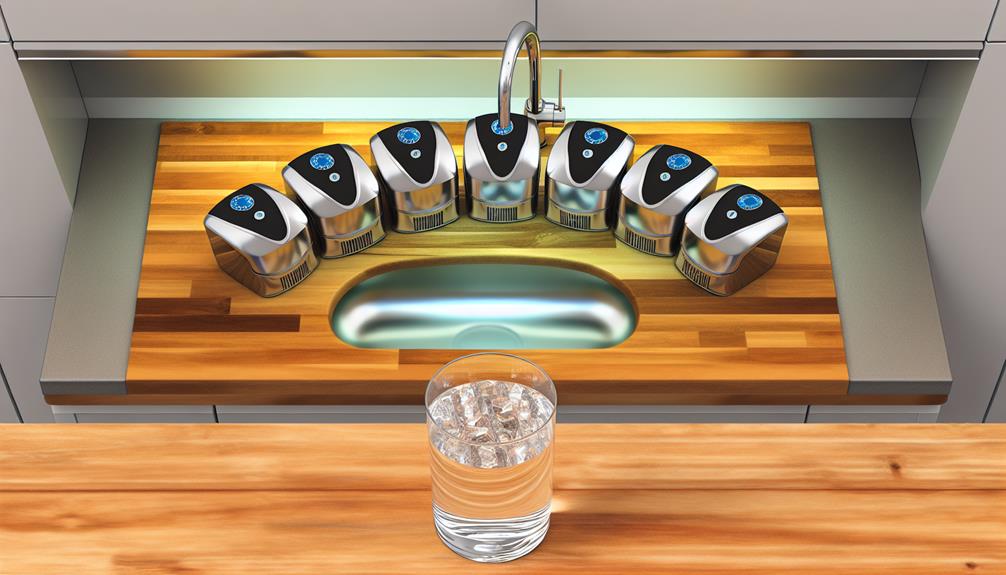
Ultraviolet disinfection units harness the germicidal properties of UV light to effectively neutralize pathogens in your home's water supply. This method doesn't involve chemicals and therefore doesn't introduce new contaminants or alter the taste and odor of your water. It's crucial to understand both the capacity and limitations of these systems.
When considering ultraviolet disinfection units, keep these points in mind:
- UV Lamp Lifespan: Most UV lamps need replacing approximately every 12 months. However, the actual lifespan can vary based on water quality and usage. Consistently monitoring and maintaining the lamp is essential for sustained performance.
- Installation Considerations: Ensure that your home's plumbing can accommodate the unit. Space for the chamber and access to an electrical outlet are necessary. Professional installation might be advisable to ensure correct setup and operation.
- Pre-Filtration Requirement: Sediment pre-filters are often necessary to remove particulates that could shield microorganisms from UV exposure, diminishing the system's efficacy.
- Flow Rate Compatibility: The unit's flow rate must match your home's water usage. An undersized unit can lead to insufficient exposure time, compromising disinfection.
Opting for a UV disinfection system requires a blend of technical knowledge and practical application to achieve the desired water quality. Always consult with a specialist to tailor the system to your specific needs.
Under Sink Water Filters
While ultraviolet disinfection units tackle microbial contaminants, under sink water filters offer a more comprehensive solution, capturing a variety of impurities directly at the point of use. These systems are typically installed in the cabinet below the sink, connecting to the existing plumbing. When considering an under sink water filter, you must evaluate the installation considerations.
These include the availability of space, compatibility with your plumbing, and whether you'll need a dedicated faucet. Some designs may require professional installation, while others are more DIY-friendly.
Filter design is a critical aspect that dictates the efficacy and maintenance requirements of the system. Under sink filters come in different forms, such as simple carbon filters or more advanced reverse osmosis units. The complexity of the filter design often correlates with the level of purification it provides.
For example, a multi-stage filter that includes sediment filtration, activated carbon, and reverse osmosis can reduce a broader spectrum of contaminants, including sediments, chlorine, heavy metals, and certain chemicals.
To ensure optimal performance, you'll need to adhere to the manufacturer's guidelines for filter replacements and system maintenance. Properly maintained, under sink water filters can provide you with clean, great-tasting water directly from the tap, contributing to your household's water quality and safety.
Countertop Filtration Solutions
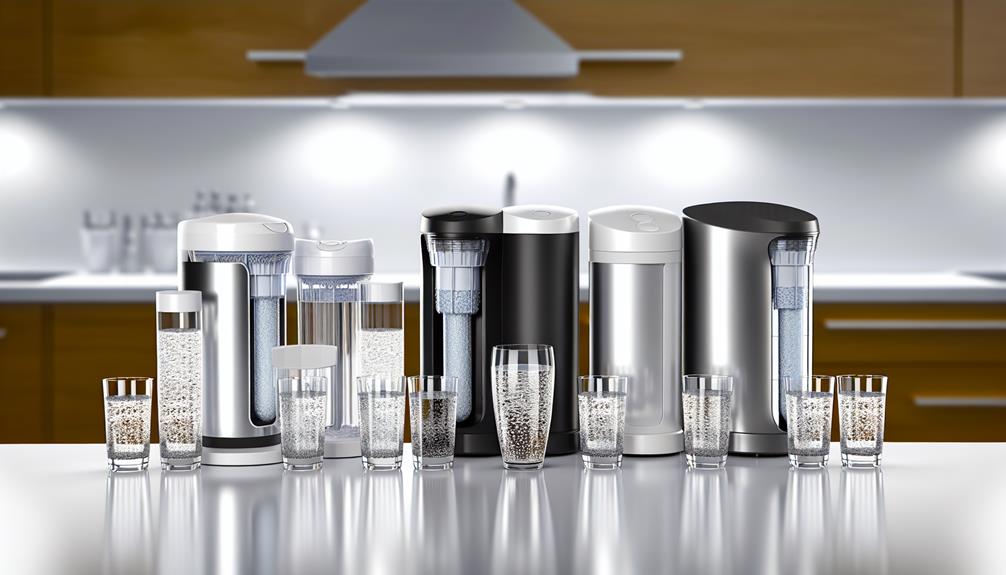
You're likely considering countertop filtration systems for their convenience and ease of installation.
Assessing popular models requires a close look at their filtration efficiency, which varies significantly.
It's critical to compare these systems on their ability to remove contaminants, life span, and overall cost-effectiveness.
Popular Countertop Models
Countertop water filtration systems offer a convenient and space-saving solution for improving your tap water's quality and taste. When you're evaluating popular models, consider these factors:
- Installation Ease: Look for systems that require minimal setup, ideally without the need for professional assistance.
- Aesthetic Appeal: Choose a design that complements your kitchen decor and doesn't clutter your countertop.
- Filtration Technology: Assess the type of filtration used, such as activated carbon or reverse osmosis, and its effectiveness in removing contaminants.
- Maintenance Requirements: Understand the frequency of filter changes and the ease of obtaining replacement filters.
Filtration Efficiency Comparison
When comparing filtration efficiency across various countertop water filtration systems, it's crucial to examine the percentage of contaminants each model can remove. You'll find that some systems are adept at eliminating chlorine, lead, and volatile organic compounds (VOCs), boasting up to 99% removal rates for these substances. Other models may specialize in eradicating heavy metals or improving water taste and odor.
Delving into filter lifespan is also essential. Some options require frequent changes every two months, while others can last up to six months or more before necessitating a replacement. This directly impacts cost analysis, as longer-lasting filters may present higher upfront costs but ultimately offer savings over time.
Assessing both efficiency and economic factors enables you to make an informed decision that balances health benefits with budget considerations.
Conclusion
In conclusion, you have a myriad of options for home water filtration, each with unique benefits.
Reverse osmosis systems offer multi-stage filtration, while activated carbon filters excel at removing organic compounds.
Consider whole house filtration for comprehensive coverage, or opt for ultraviolet disinfection to target microorganisms.
Under-sink water filters provide point-of-use convenience, and countertop solutions are ideal for easy installation.
Analyze your water quality and consumption needs to select the most effective system for your home.
